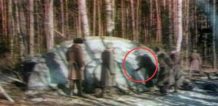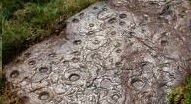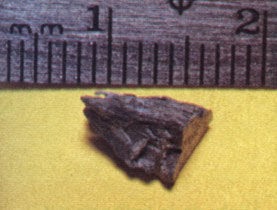The UFO Fragment of Ubatuba – BRAZIL


A well-known Brazilian newspaper announced with a prominent headline: “A fragment of a flying saucer”. Meanwhile the columnist, Ibrahim Sued received an anonymous letter in the editorial office of the same newspaper. The letter read verbatim: Dear Mr. Ibrahim Sued:
As a loyal reader of your column and admirer of your self, I want to tell you something of great interest to a man in the press about flying discs, if you believe they\’re real, of course. I didn\’t believe anything that was said or published about them, but a few days ago I was forced to change my mind. I was fishing together with some friends in a place near the town of Ubatuba, Sao Paulo, when I saw a flying disk that was approaching the beach at an incredible speed, so that a collision in the sea seemed imminent. At the last moment, however, as it was about to hit the waters, it made an upw̳a̳r̳d turn and rose with fantastic momentum.
We followed the show with our own eyes, amazed to see the disk burst into flames. It disintegrated into thousands of flaming shards that fell sparkling with magnificent brilliance. They looked like fireworks, despite the midday crash time. Most of the fragments, almost most of them fell into the sea… but a number of small pieces fell near the beach and we collected a large quantity of this material, as light as paper. I enclose a small sample…
The anonymous author of the letter sent the fragments to Mr. Sued trusting that he would know someone capable of analyzing them correctly. The author assumed that scientists always want physical evidence of U̳F̳O̳s, and that these fragments could be of great importance.
Dr. Fontes after hesitating typical of the scientific mind and his analyst to the fullest, with great discretion contacted the columnist Mr. Sued and that is how he entered the investigation of this alleged U̳F̳O̳.

According to their writings the samples were three small pieces of a solid, opaque gray, metal-like substance with a somewhat irregular and heavily oxidized surface.
In the doctor\’s judgment, the pieces appeared to have disintegrated from a large mass of metal or object. The surface of one of the pieces was crossed with microscopic cracks, always longitudinal, as if it had been broken under the action of various forces. All three samples were covered with a thin layer of whitish material that could be removed with a finger nail.
When Dr. Fontes took these fragments in his hands, he was able to verify that they were as light as paper. He asked columnist Mr. Sued for a sample to get proper analysis and better answers about what exactly had been found that day on Ubatuba beach.
One of the best laboratories in Brazil is the Mineral Production Laboratory, a division of the National Department of Mineral Production of the Ministry of Agriculture. This laboratory is the official Brazilian institution that examines minerals, metallic minerals, metals and alloys. In 1957, the year of the Ubatuba discovery, the laboratory\’s chief chemist was Dr. Feigl. Dr. Feigl and his associates decided to do a full analysis of one of the three samples submitted by Dr. Fontes and returned the other two. For simplicity, they named the sample No. 1. The sample contained longitudinal fissures and small cracks.
The lab had two things in mind. First, see if this sample was a metal as suspected. Second, if it was, they wanted to determine its chemical composition. The strategy was, of course, to detect unusual characteristics to identify the sample against substances that are ordinarily found on our planet.
First, the metal examination was conducted in the following manner. A small piece of sample No. 1 was placed in a test tube. Drops of phosphomolybdic acid and dissolved hydrochloric acid were added. A bluish color then appeared in the tube, confirming that the material was metallic.
The next test performed on the sample was spectrographic analysis, an extremely sensitive test that determines what basic metal it is, as well as its total chemical composition. The examination was able to determine minute traces of elements undetectable by all means known in those years.
The basis of the procedure is as follows: each metal has a spectrum, unique in its kind. Under normal conditions, the test outputs the spectrum and all compounds are resolved into their components.
Dr. Luisa Maria A. Barbosa, chief chemist of the laboratory\’s spectrography section, was entrusted with the task of conducting the spectrographic analysis. With the help of a great Hilger spectrograph, known for its precision and credibility, she identified the metal as magnesium, but magnesium of unusual purity.
Despite everything, Dr. Fontes wanted independent analyzes from other laboratories, and that is how sample No. 1 reaches the hands of Elson Texeira, a chemical spectrum analyst from another laboratory.
The results established with certainty that it was a magnesium of absolute purity, devoid of the microelements usually present in almost all metals.
Small samples No. 1 were also analyzed by Major Robert Caminha and Commander J.G. Brandao, both from the Brazilian Navy, whose results were never known.
Another analysis carried out on this test No. 1 was the so-called Ra i s X by diffraction. This widely used system for alloy identification pinpoints the crystal structure of different compounds. Professor Elysiario Tavora Filho was the one who directed these analyses. After extensive studies and using the ASTM standard for purity as a reference, Professor Filho determined to his astonishment that the magnesium sample was purer than the ASTM standard itself. As a scientist, he found it difficult to understand the harsh reality of the evidence.
Professor Filho, perhaps to protect his reputation, did not make a written report of his analyses, although he sent numerical results to Dr. Fontes, and did not discuss theories about the origin of the samples.
Dr. Fontes, with all this information, determined that the piece of sample analyzed would surely come from an aerial object not made by man. In his thinking, most explosions probably occur at high altitudes, so the chunks char before they hit the ground. The Ubatuba accident, on the other hand, occurred close to the ground, and even more so close to the coastline, which allowed the recovery of fragments as physical evidence.
A study of the two samples that were left to Dr. Fontes was taken to the United States. The authors of these studies were Dr. Walter Walker , a professor at the University of Arizona and a former Hughes Aircraft Corporation engineer, and Dr. Robert Johnson , manager of the Crystallography Division of the Materials Research Corporation in New York.
The report of these American scientists determines that samples No. 2 and 3 were not as pure as the magnesium in sample No. 1. They contained traces of stronium, barium, calcium, and zinc. However, in their studies, they included the following observations:
“The Ubatuba samples are close to monocrystalline. All researchers agree that the samples are foundries. If these are castings and have grains large enough to approach mono-crystallinity, then these samples must have been very slowly and carefully cooled from the liquid state. This slow cooling is not normal for commercial magnesium ingots or cast irons. The extremely large, oriented, molten grains in the Ubatuba sample are rare and cannot be easily obtained by stochastic sampling of magnesium and its alloys.”
Despite these studies, Drs Walker and Johnson agree that the ex̳t̳r̳a̳t̳e̳r̳r̳e̳s̳t̳r̳i̳a̳l̳ origin of the Ubatuba material cannot be proven or refuted with certainty. Both believe that there is a basic difficulty in using physical evidence to establish the ex̳t̳r̳a̳t̳e̳r̳r̳e̳s̳t̳r̳i̳a̳l̳ origin of a material. His statements were as follows:
Even possessing a genuine article or material made with ex̳t̳r̳a̳t̳e̳r̳r̳e̳s̳t̳r̳i̳a̳l̳ technology there are the following problems in the investigation of those materials or articles:
1º The ex̳t̳r̳a̳t̳e̳r̳r̳e̳s̳t̳r̳i̳a̳l̳s used methods within the limits of our technology and materials available on Earth; therefore, his work could not be distinguished from ours.
2º The ex̳t̳r̳a̳t̳e̳r̳r̳e̳s̳t̳r̳i̳a̳l̳s used materials not available on Earth or methods superior to our technology, but the evidence of it cannot be detected by any means.
3º The ex̳t̳r̳a̳t̳e̳r̳r̳e̳s̳t̳r̳i̳a̳l̳s used methods superior to our technology or non-terrestrial materials, but we lack the techniques to detect one or the other possibility.
4th The material is not found on earth and/or the methods used are superior to our technology. Evidence of ex̳t̳r̳a̳t̳e̳r̳r̳e̳s̳t̳r̳i̳a̳l̳ origin exists in the sample and our techniques can detect it.
Ten years after all these analyzes of the samples in question, Dr. Robert Ogilvie, professor of metallurgy at the Massachusetts Institute of Technology also announced his conclusions:

“The sample from Brazil has a composition that could be found in welded metal. However, the structure is truly unusual. It could only have been formed by heating magnesium very close to its melting point in air. It would suffice to maintain the temperature for a minute or so.
This would produce a layer of oxide on the external surface of the material, which is clearly visible, and also the oxygen would diffuse through the perimeters of the grains producing an oxide network. Therefore, it is possible that the sample from Brazil is a piece of welded metal from the explosion of a ship or satellite that returns to Earth.”
Regardless of the scientists\’ conclusions, an interesting document was distributed at the International Congress of Space Medicine on January 29, 1976 by the C̳I̳A̳. In a clear allusion to the Ubatuba event, the document relates the following, calling it “Information not evaluated.”
“Scientists in the United States believe that low-intensity magnetic fields do not have serious effects on astronauts, but high-intensity fields, oscillating magnetic fields, and electromagnetic fields can or do have significant effects. There is a theory that these fields are closely associated with superconductivity at very low temperatures such as those in space. This, in turn, is related to the U̳F̳O̳ propulsion system. It is said that fragments of a possible U̳F̳O̳, found in Brazil, are related to superconductors and magnetohydrodynamics.”
To date these fragments remain a mystery. However for Dr. Olavo Fontes, who died several years after his first investigations, the proof was there. He was perfectly convinced that the samples he was holding in his hands were strong physical evidence of the existence of U̳F̳O̳s.
The last years of his life underwent a real transformation. He had found that “something” that many researchers do not know how to explain, and that despite the years that have passed since the events of Ubatuba, there are still unknowns and indecipherable paths.




